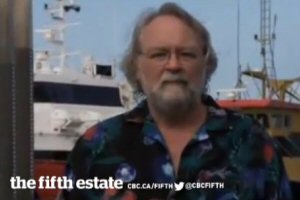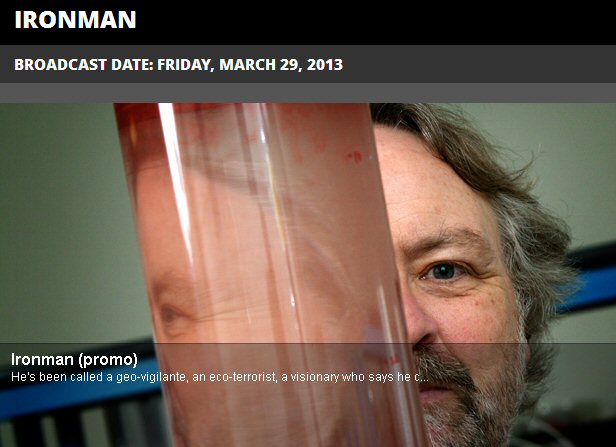CBC-TV Investigates Former LENR Researcher Russ George

March 26, 2013 – By Steven B. Krivit –
On Friday evening, Darcy Russell George, a former LENR researcher, will be featured on the Canadian Broadcasting Corp.’s “Fifth Estate” program. The program is an investigative news show similar to CBS’s “60 Minutes” in the U.S. CBC will be focusing primarily on George’s latest attempts to sequester carbon in the ocean.
The show likely will be viewable only in Canada. A short promotional clip is available on the Fifth Estate Web site.
CBC producers asked investigative journalist Steven B. Krivit, who specializes in LENR (low-energy nuclear reaction research), which was once believed to be “cold fusion,” to speak on the activities and strategies of George.
Throughout the 1990s and into the 2000s, George was involved in several “cold fusion” research projects, usually as a guest technician. He has no college degree and no professional training as a scientist.
But it was George’s more recent non-energy-related activities that attracted the attention of CBC. Last year, he dumped 100 tons of iron ore in the ocean, allegedly to help the environment and make money from carbon credits.
George attracted the attention of New Energy Times in 2005, when he began telling people that he had received $2 million to perform research and development in “cold fusion.” He also began telling people that, within a period of months his company would start selling 1,000-Watt “cold fusion” heating units.
The main problem with his promotion was that the typical current results, at the time, and still today, are a few hundred milliwatts of excess heat. In his case, two of his colleagues who agreed to allow George to represent their work as part of his company, D2Fusion, had only one experiment that produced 300 milliwatts of excess heat for a few hours.
But only George, and perhaps two of his colleagues, knew this. George didn’t tell other researchers in the field or the public that the 300-milliwatt result was the best scientific basis for his promised home heating unit. This information did not become public until New Energy Times investigated and published its report.
The difference between 300 milliwatts and 1,000 Watts is a factor of 3,000. Imagine an automobile manufacturer which sells a car that gets 40 miles to the gallon claiming that, in a few months, it will start selling a car that gets 120,000 miles to the gallon.
George is no longer active in the LENR research field. While he was active in “cold fusion” he was working in parallel on another project. He was attempting to perform ocean seeding through his company Planktos, and he went on to pursue those opportunities. After his first attempts at ocean seeding in the South Pacific failed, he came up with another plan.

After forming a company in 2008 called Haida Climate, George eventually performed a massive eco-engineering dump in 2012 in international waters off the coast of Canada. He collaborated with a local native group, the Old Masset Village Council, which is part of the Haida Nation.
A local man named John Disney worked as George’s proxy and sold the villagers on the idea. With the encouragement of the council, George and Disney persuaded members of the indigenous community to pay about $2 million to fund George’s ocean-seeding venture. George rented a fishing boat and flew the Haida Nation flag as he dumped 100 tons of iron ore in the ocean in 2012. The Old Masset Village Council declared that it was a sovereign state and therefore not bound to Canadian or international laws.
Here’s what we know so far about how it happened: George gained the confidence of, and worked through Disney, chief executive officer of the newly formed (2011) Haida Salmon Restoration Corp. Disney, in turn, gained the confidence of the local village council. Then the council gained the confidence and agreement of a majority of the community, primarily by assuring them that the dumping program and subsequent plankton bloom would bring the salmon back to normal levels; the lifeblood of their community, economy and culture. George and Disney also promised the council that the venture would permanently sequester carbon dioxide from the atmosphere, that the village could, in turn, issue certified carbon credits, sell them, and profit on their $2 million investment.
The Haida Nation denounced the actions of George, Disney and the Old Masset Village Council.
George presented the venture as a scientific test, but he has no scientific credentials, has not identified any credentialed scientists who worked with him on the venture and has not published any data on the venture.
CBC asked Krivit to help it understand George’s history and his common strategies. The following list summarizes George’s common business practices.
1. Invents Business Transactions
George invents business transactions, sometimes between his own corporations, to give the appearance that those corporations, which usually exist only on paper, have value. Usually, they have no assets.
2. Uses Scientists’ or Institutions’ Names Without Permission or Authorization
George uses the names of recognized, qualified scientists and institutions without their permission, in association with himself, to give the appearance that his businesses have value, recognition and prestige.
3. Creates Illusions That He Has Supportive Scientific Data
George uses the allure of science to give the impression that his proposed technologies are supported by credible scientific research when, in fact, they often are not.
4. Makes False Claims to Ownership of Credible Scientific Data
Of the credible science that George claims as his own research, most of the data and research belong to someone else.
New Energy Times has published examples of each of these practices on the Web page: Investigations of Russ George’s Low-Energy Nuclear Reaction Research (LENR) and Plankton Carbon-Credit Activities.
[The sentence: “the state-of-the-art in LENR research, at the time, and still today, was and is a couple of watts of excess heat that last for a few minutes” has been corrected to read “the typical current results, at the time, and still today, are a few hundred milliwatts of excess heat.”]
______________________________________________________________
Questions? Comments? Submit a Letter to the Editor.

